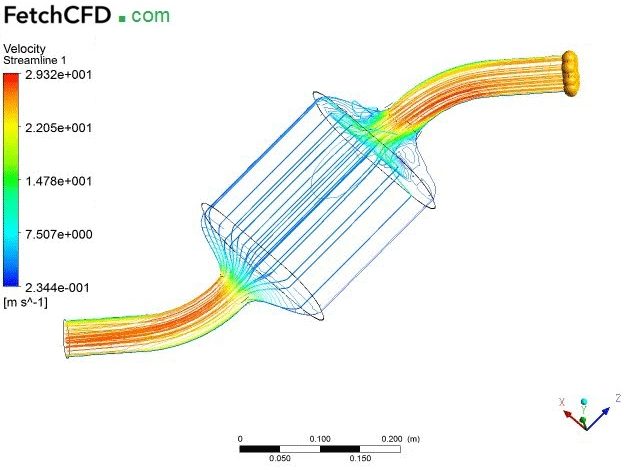
An exhaust catalytic converter is part of the exhaust system, which processes all exhaust leaving the engine before escaping into the atmosphere. It is imperative to address the issue immediately if you notice a clogged or bad catalytic converter. There is no requirement to replace the catalytic converter if you have catalytic converter problems. This guide will lead you toward the cheapest way to fix the catalytic converters.
Catalytic converters
Electronic controls and emissions control devices, such as catalytic converters, are helping make automobiles today cleaner and more powerful than ever before. A spark or the heat of compression ignites the reaction between fuel and oxygen in the air. This chemical reaction would produce only motive energy, water vapor (H2O), and carbon dioxide (CO2) in an ideal world. The ideal is challenging to achieve in real-world driving conditions, resulting in harmful emissions.
Catalytic converters use precious metals and high heat to oxidize and reduce harmful emissions, transforming them into safer compounds like water, carbon dioxide (CO2), and nitrogen (N2). Catalytic converters are expensive because they use rare metals like platinum, palladium, and rhodium. They can cost upwards of $1,000 (not including diagnosis and installation).
Symptoms of a bad catalytic converter
The engine accelerates slowly or is difficult to start. Catalytic converter clogs may obstruct exhaust flow out of the machine, causing these issues. Clogged catalytic converters essentially choke the engine, preventing it from exhaling its exhaust.
The smell of sulfur or “rotten eggs” indicates the formation of hydrogen sulfide (H2S), a sign of contamination of the catalytic converter. Poor catalyst function could also be characterized by an ammonia odor (NH3).
It is possible that the catalytic converter’s housing is discolored or warped due to internal leakage or overheating.
It may indicate a broken catalyst if the engine makes a rattling sound when it starts.
A failed catalytic converters could also explain a failing annual or semi-annual emissions test.
Check your vehicle’s warning lights. Typically, catalytic converters problems are detected by an illuminated check engine light or malfunction indicator lamp (CEL or MIL) and a diagnostic trouble code (DTC) when the catalytic converter malfunctions, the engine control module (ECM) might record the fault code P0420, “Catalyst System Efficiency Below Threshold,” when the catalytic converter malfunctions.
5 cheapest ways to fix a catalytic converter
1. “Italian tuning-up”
An “Italian Tune-Up” fixes various automotive issues, including clogged catalytic converters. Most drivers fail to drive hard enough to get their catalytic converter to its most-efficient temperature of between 800°F (426°C) and 1,832°F (1,000°C), leading to premature failure.
Performing multiple hard accelerations in a vehicle may heat the converter enough to burn off performance-robbing deposits in the intake, the cylinder head, the exhaust, oxygen sensors, and the catalytic converter.
2. Fuels Additives
Using another fuel or “additive” may be more effective in cleaning out catalytic converter deposits. Try changing from low-octane power to high-octane fuel if you usually fill your vehicle with the cheapest fuel. You may also clear catalytic converter deposits at your next refuel by adding one gallon of lacquer thinner to ten gallons of gasoline. Combined with the Italian Tune-Up method, you can try either.
Read more: How to Make Use of Your Old Tech Devices
3. Engine Running Smoothly
To fix the catalytic converter problem, you may need to appoint other engine problems. A lazy oxygen sensor might falsely indicate a catalytic converter problem yet not set a DTC for itself. A technician can determine if the sensor is responding as it should.
Other engine problems, such as fuel trim running too rich or too lean, oil or coolant burning, or engine misfire problems, could lead to catalytic converter contamination or premature failure. Depending on the damage already done, fixing engine problems might save the catalytic converter from a meltdown.
4. Troubleshooting Exhausts
A leaky exhaust system can skew oxygen sensor readings without setting other DTCs. When exhaust leaks are repaired, catalytic converter function can be restored, at least according to the ECM. Corroded flex pipes and worn exhaust gaskets are two common problems that are much less expensive and more effective than replacing a catalytic converter.
5. Clean the catalyst.
Another option is to remove and clean the catalytic converter. Remove any contaminants from the catalytic converter matrix using a pressure washer after the converter is removed. Make sure to flush both ends of the converter.
The catalytic converter can also be cleaned by soaking it overnight in a solution of hot water and degreaser or laundry detergent. The process takes longer, but removing the deposits clogging your catalytic converter is necessary. Ensure that the catalytic converter is completely dry before reinstalling it after washing or soaking.
How to prolong the life of your catalytic converter?
Occasionally, catalytic converters must be replaced (like when it’s internally damaged or melted down). Make sure your catalytic converters last as long as possible by following these tips.
Cars love to be driven: Avoid leaving your car sitting for weeks on end, and take at least a few long trips rather than just short ones. Once a week, you should drive at highway speeds for at least 20 minutes to reach proper operating temperature.
Regular maintenance is essential, such as changing oil air filters and inspecting your car: Any issue that requires attention should be addressed as soon as possible to prevent possible damage to the catalytic converters.
Address the check engine light immediately: A lit MIL indicates that the engine is running in an open loop, based on programming instead of feedback. With the open loop, the engine may run too rich or too lean, damaging the catalytic converters.
If changing to high-octane fuel fixes your catalytic converters problem, you should consider switching to high-octane fuel periodically. Initially, a catalytic converters are cleaned out, but a permanent switch can keep it clean for the life of your vehicle.
Catalytic Converter Cost
Like any auto repair, the cost of replacing a catalytic converter varies from model to model. Catalytic converter replacement costs range from $945 to $2475. Some specialty cars could be even higher.
Nevertheless, there are other problems than catalytic converter prices. It is essential to consider diagnostic costs and possible issues that may arise due to the failure and the repair itself. One or more oxygen sensors, the muffler, or the tailpipe might have to be replaced at the same time. You can decide whether or not to proceed with the repair after analyzing the costs. The cost of repairing it might exceed the value of the car.
FAQs (Frequently Asked Questions)
Read More: Easy Phone Maintenance Tips By Cell Phone Repair Center





